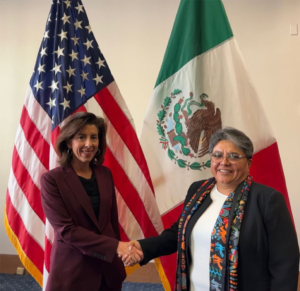by Mexico News Daily
Mexico and the United States will work together to lure companies to North America from Asia, the Economy Ministry (SE) said Friday.
After a meeting between Economy Minister Raquel Buenrostro and U.S. Secretary of Commerce Gina Raimondo, the SE said that those two officials will collaborate to put together a “joint presentation” to the private sector “to disseminate the opportunities and economic and fiscal benefits that both countries offer for the relocation of companies.”
The presentation will be put forward in the first two months of 2023, the ministry said in a statement.
Buenrostro said last month that over 400 North American companies already “have the intention to carry out a relocation process from Asia to Mexico.”
The ongoing United States-China trade war, proximity to the U.S., USMCA free trade pact-associated benefits and affordable labor costs are among the reasons why many companies are looking to shift operations to Mexico.
The SE said Buenrostro and Raimondo discussed a range of issues at their meeting in Washington, “among which the relocation of companies from Asia to North America and the strengthening of supply chains stand out.”
They particularly focused on issues related to the printed circuit board and semiconductor sector, the ministry said.
The United States earlier this year invited Mexico to take advantage of massive U.S. investment in the semiconductor industry. The U.S. Department of Commerce released a strategy in September outlining how it would implement US $50 billion from the CHIPS and Science Act of 2022, an executive order that U.S. President Joe Biden signed in August.
According to the SE statement, Buenrostro and Raimondo agreed that “the relocation of companies is a historic opportunity for the strengthening and economic integration of North America,” where the USMCA has been in effect since the middle of 2020.
“Through [the U.S.-Mexico] High-Level Economic Dialogue, both governments agreed to strengthen coordination to create better [economic] conditions and accelerate the arrival of new investment to Mexico,” the ministry said.
It noted that Buenrostro highlighted that Mexico has the workers companies that relocate here will need, and that she and Raimondo “emphasized the importance of the Economy Ministry acting as a one-stop shop for the attraction of capital.”
In other words, the SE should issue all “permits and authorizations required for the establishment of new companies” in Mexico.
The ministry also said that Buenrostro and Raimondo agreed that energy security, food security and national security are “the main pillars on which the region’s economic development rests.”
In a brief press release, the U.S. Department of Commerce said that the two officials discussed “how Mexico and the United States can collaborate to develop more resilient supply chains.”
“They also discussed areas of mutual interest such as renewable energy,” it added.
Buenrostro’s talks with Raimondo came a day after she met United States Trade Representative Katherine Tai. At that meeting, the economy minister proposed establishing “trinational working groups” that would meet in December and early January to “deal with the different aspects of” the energy dispute between Mexico and its two North American trade partners.
In July, both the U.S. and Canada requested dispute settlement consultations with Mexico, arguing that the Mexican government is violating the USMCA with policies that favor state-owned energy companies over private and foreign ones, including many that generate renewable energy.
According to the SE statement, Buenrostro and Raimondo agreed that “the relocation of companies is a historic opportunity for the strengthening and economic integration of North America,” where the USMCA has been in effect since the middle of 2020.
“Through [the U.S.-Mexico] High-Level Economic Dialogue, both governments agreed to strengthen coordination to create better [economic] conditions and accelerate the arrival of new investment to Mexico,” the ministry said.
It noted that Buenrostro highlighted that Mexico has the workers companies that relocate here will need, and that she and Raimondo “emphasized the importance of the Economy Ministry acting as a one-stop shop for the attraction of capital.”
In other words, the SE should issue all “permits and authorizations required for the establishment of new companies” in Mexico.
The ministry also said that Buenrostro and Raimondo agreed that energy security, food security and national security are “the main pillars on which the region’s economic development rests.”
In a brief press release, the U.S. Department of Commerce said that the two officials discussed “how Mexico and the United States can collaborate to develop more resilient supply chains.”
“They also discussed areas of mutual interest such as renewable energy,” it added.
Buenrostro’s talks with Raimondo came a day after she met United States Trade Representative Katherine Tai. At that meeting, the economy minister proposed establishing “trinational working groups” that would meet in December and early January to “deal with the different aspects of” the energy dispute between Mexico and its two North American trade partners.
In July, both the U.S. and Canada requested dispute settlement consultations with Mexico, arguing that the Mexican government is violating the USMCA with policies that favor state-owned energy companies over private and foreign ones, including many that generate renewable energy.
300 kg of fentanyl-laced pills found inside coconuts in Sonora
A load of coconuts on a truck being driven in the northern state of Sonora contained approximately 300 kilograms of pills believed to be laced with fentanyl, according to the agencies that made the seizure on Thursday.
Thousands of blue pills were found in plastic bags hidden inside hundreds of coconuts, which had been cut in half, scraped out and glued back together, a video posted by the Attorney General’s Office (FGR) indicates. In one image, an officer can be seen busting open a coconut by hitting it against the ground.
Two people allegedly transporting the cargo were arrested after their truck was intercepted on a federal highway near Pitiquito, a municipality about 90 kilometers south of Mexico’s border with Arizona. The operation was conducted by several agencies both national and regional.
Few details were provided, aside from an FGR tweet stating that “approximately 300 kilograms of a substance with characteristics of fentanyl” was seized “in a truck that was transporting coconuts.” A press release from the federal office offered several pictures but few additional details.
The newspaper Reforma said the value of the seizure was “about US $60 million,” citing a price of US $200,000 per kilo given recently by Secretary of Defense Luis Cresencio Sandoval.
Fentanyl is “a highly addictive synthetic opioid that is 50 times more potent than heroin and 100 times more potent than morphine,” according to the U.S. Drug Enforcement Agency.
Pills containing fentanyl are “largely made by two Mexican drug cartels, the Sinaloa Cartel and the Jalisco [New Generation] Cartel (CJNG), to look identical to real prescription medications, including OxyContin, Percocet and Xanax, and they are often deadly,” the DEA says on its website.
The two cartels, “using chemicals largely sourced from China, are primarily responsible for the vast majority of the fentanyl that is being trafficked in communities across the United States,” the DEA adds.
Despite being fierce rivals, the Sinaloa Cartel and the CJNG are getting the chemicals to produce fentanyl from the same suppliers, InSight Crime reported, referring to a report from Mexico’s National Intelligence Center cited in the Milenio newspaper.
The DEA cites figures from the Centers for Disease Control and Prevention (CDC) stating that 107,622 Americans died of drug poisoning in 2021, with 66% of those deaths involving synthetic opioids such as fentanyl. The agency says it seized more than 20.4 million fake prescription pills in 2021.
“The pill form is very scary because they’re made to look like legitimate pharmaceuticals,” Greg Millard, an acting special agent with the DEA, told El Paso, Texas, TV station KTSM.
“When people buy the pill on the street, they think they’re getting what maybe [is] a pill bought from a pharmacy prescribed by a doctor but sold on the black market,” he added. “However, they’re not. They’re getting a pill made somewhere south of the border containing fentanyl.”
The DEA conducted a laboratory study this year that found that six out of every 10 such fentanyl-laced pills contain a potentially lethal dose of the drug (an increase from four out of 10 in 2021).
“Just two milligrams of fentanyl, the small amount that fits on the tip of a pencil, is considered a potentially deadly dose,” the agency said in its report.
Large amounts of fentanyl, meth and other drugs have been seized recently in Sonora and elsewhere. Millard told KTSM that “profit and greed are driving the Mexican drug cartels” to push fentanyl-laced pills.
“It’s easy to produce. It’s easy to get the chemicals,” he said. “With the other drugs [heroin, marijuana and cocaine], you have to grow a plant. … But fentanyl is produced in a laboratory, it’s produced clandestinely. It’s just chemicals mixed together.”
With reports from Reforma and Reporte Indigo




